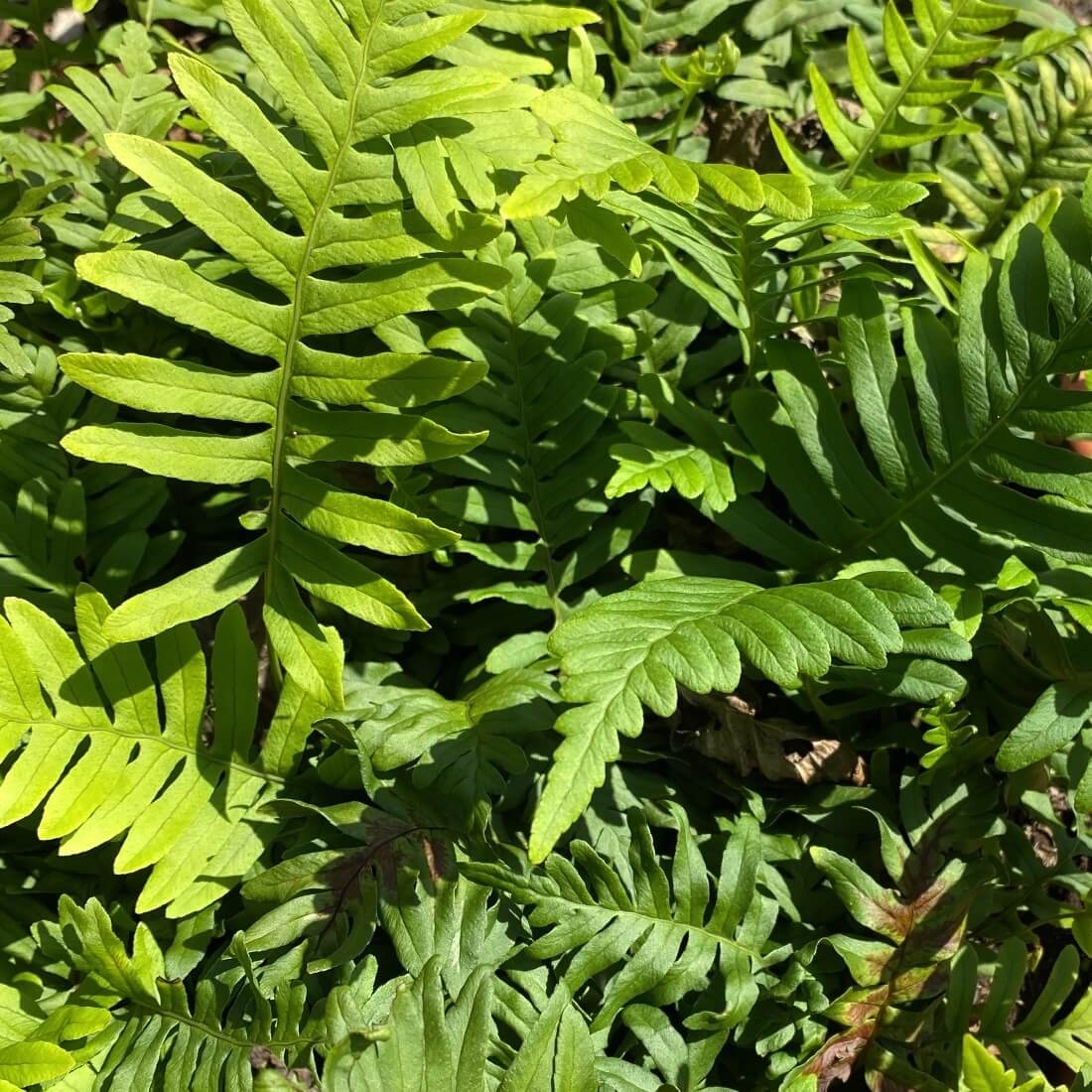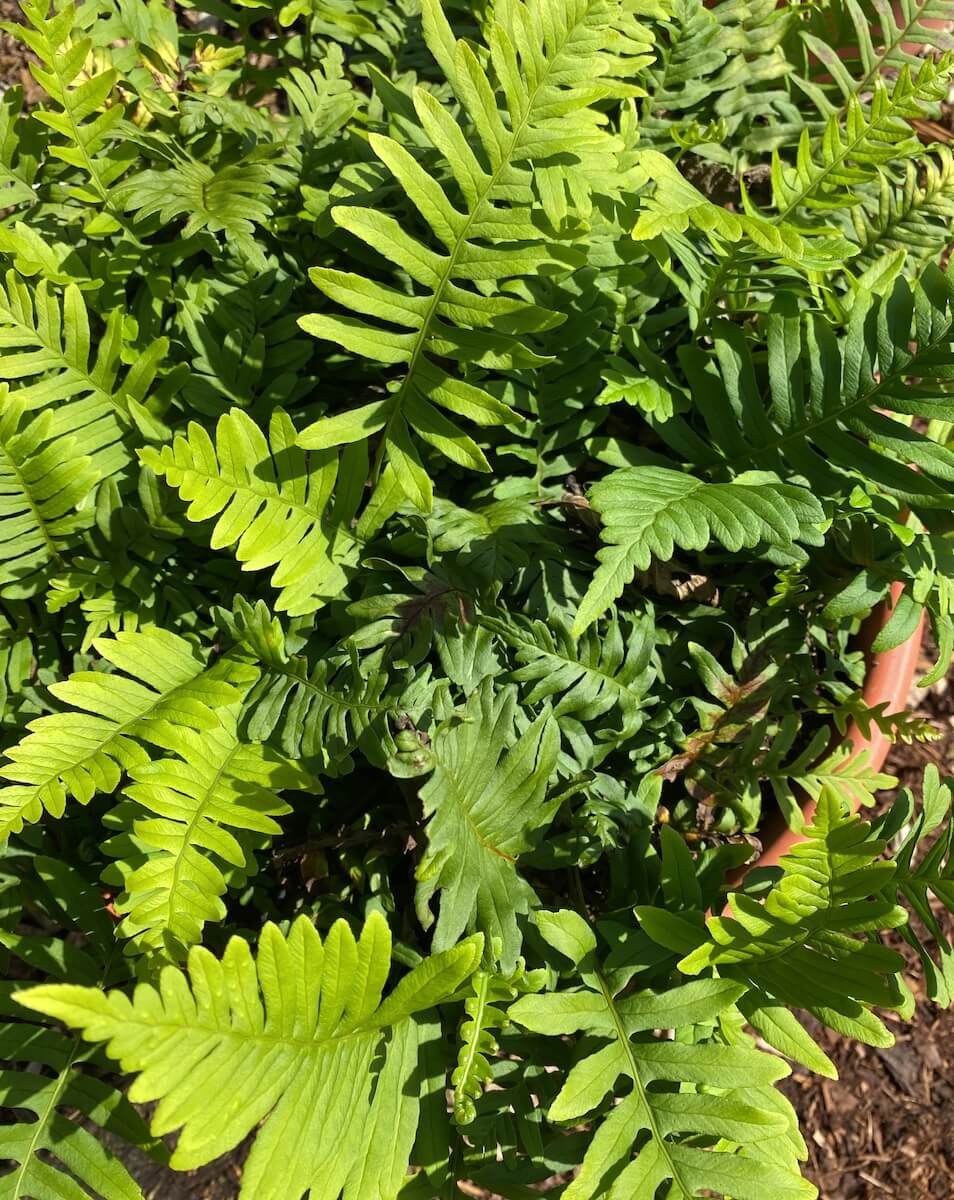
Position
- Partial to full shade
- Sheltered or exposed sites
- North or east-facing aspects ideal
- Can grow on walls, trees, and rocks
- Woodland settings perfect
- Tolerates dry shade once established
Hardiness
- Tolerates temperatures down to -25°C (-13°F)
- Evergreen fern
- Very hardy throughout the UK
- Performs well in coastal areas
Soil
- Well-draining conditions
- Adapts to most soil types
- Can grow with minimal soil in rock crevices
- Benefits from leaf mould incorporation
- Tolerates both acidic and neutral pH
- Grab a soil test kit and ensure the perfect conditions for growth
Height
- Height: 20-30cm (8-12 inches)
- Spread: 45-60cm (18-24 inches)
- Takes 3-5 years to form good colonies
Seasons of Interest
- Evergreen leathery fronds
- New growth in late summer
- Golden-brown spore cases in autumn
- Year-round architectural presence
- No flowers (ornamental fern)
Additional Notes
- Native to British woodlands and walls
- Excellent for naturalising
- Perfect for rock gardens
- Low maintenance once established
- Good for containers
- Minimal watering needed
- Deer and rabbit resistant
- Good for urban gardens
- Works well under trees
- Benefits from occasional removal of old fronds
- Tolerates exposed conditions
- Does well in north-facing aspects
- Good for small gardens
- Creates natural woodland effect
- Compact growth habit
- Never becomes invasive
- Historic medicinal uses
- Good between paving stones
- Excellent for green walls
- Can colonise tree trunks
- Drought tolerant once established
- Self-sustaining in ideal conditions
Polypodium vulgare – A Timeless Choice for Natural Texture and Evergreen Beauty
Polypodium vulgare, commonly known as the Common Polypody, is a native fern celebrated for its effortless charm and impressive adaptability. With its leathery, evergreen fronds and ability to thrive in tricky spots, it’s a dependable addition to any shaded garden. Whether creeping along a woodland floor, softening the edge of a dry stone wall, or nestling among tree roots, this hardy fern adds year-round interest and a quietly architectural quality to your planting scheme.
Key Features and Growth Habit
The Common Polypody typically forms low, spreading colonies that reach 20–30cm (8–12 inches) tall, making it ideal for ground-hugging coverage. Its upright, deeply-lobed fronds emerge from creeping rhizomes, slowly expanding to form attractive natural carpets. Each frond is leathery and displays simple, narrow divisions with unmistakable rounded sori (spore cases) that turn a rich golden-brown in late autumn. These unique spores add visual texture and highlight the plant’s reproductive strength and adaptability.
Where and How It Grows Best
This fern is especially well-suited to partial or complete shade, where many other plants might falter. Polypodium vulgare can thrive in less-than-ideal soil, growing happily in well-drained garden beds, in the crevices of old walls, and even on mossy tree trunks. Thanks to its creeping rhizomes, it easily establishes itself in stable colonies that gently spread without becoming invasive.
Seasonal Interest and Evergreen Value
Unlike many ferns that retreat underground in winter, Polypodium vulgare maintains its foliage throughout the colder months. Fresh fronds unfurl in late summer, providing rich green colour through autumn and winter. The rounded spore cases develop as the seasons cool, creating an attractive contrast against the darker fronds. Its evergreen nature gives the plant structure during the dormant season, helping maintain visual interest when much of the garden lies bare.
Garden Design Uses and Creative Applications
Polypodium vulgare’s modest size and clump-forming habit make it versatile for various garden styles. In woodland gardens, it works beautifully as a textural groundcover beneath trees or alongside winding paths. Its ability to thrive on vertical surfaces like stone walls or among rocks allows it to soften hardscaping and add lush, green accents to dry, shaded corners. It’s also ideal for cottage gardens, wild gardens, and naturalistic planting schemes.
This fern offers a low-maintenance solution with a visual payoff for urban or small-space gardens. Its compact nature suits container growing, particularly in wide, shallow pots that replicate its natural rooting habits. Use it on patios or shaded balcony corners to bring some woodland magic to even the smallest outdoor spaces.
Easy-Care Nature and Minimal Maintenance
Once established, the Common Polypody is exceptionally easy to care for. It requires little feeding or pruning. In late winter, simply remove any damaged or tired fronds to encourage fresh growth and maintain its appearance. In woodland settings, natural leaf litter is usually sufficient to feed the plant, making additional fertilisation unnecessary.
Though drought-tolerant once settled, consistent moisture helps keep the fronds looking their best. It’s far more tolerant of dry conditions than many other ferns, mainly when grown on walls or trees with minimal soil. This makes it an excellent choice for gardeners who want structure and greenery without constant watering.
Ideal Planting Conditions and Best Practices
For best results, plant Polypodium vulgare in spring or early autumn, when the soil is moist and temperatures are moderate. Space plants around 30cm (12 inches) apart to allow room for their rhizomes to spread naturally over time. When planting into walls, gently press the rhizomes into crevices filled with moss or compost-rich material to encourage rooting.
This fern prefers neutral to slightly acidic soil and good drainage. It adapts well to sandy, loamy, or stony soils, provided excess moisture doesn’t build up. Unlike many perennials, it’s not fussy about high fertility; it tends to thrive in poorer conditions, especially where air circulation is good and shade is reliable.

Excellent Companion Plants for Woodland Style
Polypodium vulgare shines when planted with other shade-loving natives. It pairs beautifully with low-growing woodland favourites such as primroses (Primula vulgaris), wood anemones (Anemone nemorosa), and dog violets (Viola riviniana). Add clusters of early-flowering bulbs for seasonal highlights like snowdrops, winter aconites, or cyclamen. Its fine-textured fronds contrast nicely with broader-leaved plants such as hostas, brunnera, and hellebores, creating a layered, lush look.
Growing in Containers and Small Gardens
If space is limited or you want to add structure to a shady terrace or patio, Polypodium vulgare makes an excellent container plant. Choose a shallow but wide pot with plenty of drainage holes. To recreate its natural habitat, use a mix of multipurpose compost and leaf mould or bark chips. Water sparingly—overwatering is a more common problem than drought—and avoid placing it in strong direct sunlight.
Its ability to thrive with minimal soil and water makes it particularly useful for vertical gardening or green walls in shaded locations. With the proper support and moisture-retentive medium, it will happily cling to mossy logs, shady garden sculptures, or aged brickwork.
Reliable and Resilient – Few Problems to Worry About
Polypodium vulgare is a robust and resilient fern with excellent disease resistance and few pest issues. Occasionally, fronds may brown or crisp at the tips during prolonged dry weather, but these can simply be snipped back to maintain a tidy appearance. Ensure good airflow around the plant, especially in humid or enclosed spaces, to avoid any fungal issues.
Its slow but steady growth makes it a long-term performer with little need for intervention. If plants begin to outgrow their space or you’d like to propagate more, simply divide clumps in early spring or autumn and replant immediately.
Cold Hardiness and Climate Tolerance
Native to the UK and wider Europe, Polypodium vulgare is fully hardy and well-adapted to our variable climate. It tolerates temperatures as low as -25°C (-13°F), making it suitable for gardens from the south coast to the Scottish Highlands. Its ability to survive wet winters and dry summers—provided in shade—makes it an excellent choice for low-maintenance, year-round planting schemes.
From Darren’s Patch
There’s something deeply satisfying about finding a plant that knows how to get on with things, and Polypodium vulgare does that. It’s become a quiet hero in my garden—tucked into a crumbling dry stone wall, draping itself elegantly over shady corners where little else thrives. What I love most is how it brings that woodland magic into the garden, softening hard edges and staying green through winter when so much else has faded. It doesn’t ask for much—just a bit of space, some dappled shade, and a little patience—and in return, it gives texture, movement, and a lovely sense of age and permanence. I often pair it with primroses and wood anemones for a truly naturalistic feel, and I’ve even popped a few into wide containers near the back door where I can admire their quiet resilience up close. It’s a plant I’ll always make space for.
![]()
Final Thoughts
Polypodium vulgare offers gardeners a versatile and reliable choice for challenging areas. Its adaptable nature, year-round presence, and low maintenance requirements make it valuable in various garden settings.
The combination of spreading habit and evergreen foliage creates lasting interest. The Common Polypody is an essential addition to natural garden designs, whether growing on walls, as groundcover, or in containers.
The fern’s ability to colonise different surfaces, combined with its compact growth, makes it perfect for creating natural-looking plantings. Its presence adds depth and texture to areas where many plants struggle to establish.
Check out the RHS article here.
Want to learn about other fern varieties? Read about the Dryopteris filix-mas here.
For more information on ferns for your garden, please check out our guide to ferns for UK gardens.
Frequently Asked Questions
Q: How tall does Common Polypody grow?
A: Polypodium vulgare – Common Polypody typically reaches 20-30cm (8-12 inches). Its spreading habit creates effective groundcover while maintaining a manageable height.
Q: What growing conditions does Common Polypody prefer?
A: This adaptable fern thrives in partial to full shade. It grows well on walls, tree trunks, and rocks, preferring well-draining situations.
Q: How hardy is Common Polypody?
A: The Common Polypody withstands temperatures below -25°C (-13°F). It remains evergreen through winter and adapts well to various UK climates.
Q: When should I plant Common Polypody?
A: Plant in spring or autumn when conditions support root establishment. The cooler temperatures and increased moisture help new plants settle in.
Q: Does it need much maintenance?
A: Once established, Common Polypody needs minimal care. Remove any brown or damaged fronds occasionally to maintain its appearance.
Q: Can I grow it in containers?
A: Yes, Common Polypody grows well in containers. Use shallow, wide pots with good drainage and a moisture-retentive growing medium.
Q: How quickly does it spread?
A: The fern spreads gradually through creeping rhizomes. It creates natural-looking colonies over several years without becoming invasive.
Q: What makes it different from other ferns?
A: Common Polypody stands out with its ability to grow on walls and trees. Its evergreen nature and distinctive spore patterns add year-round interest.
Q: Will it grow on my garden wall?
A: Yes, this fern often colonises walls naturally. Ensure some organic matter collects in cracks and crevices to support initial growth.
Q: What companion plants work well with it?
A: Common Polypody pairs beautifully with woodland plants like primroses and wood anemones. It also complements winter-flowering hellebores and early bulbs.
